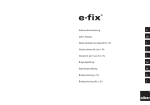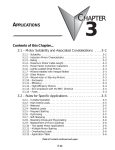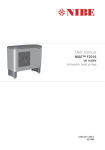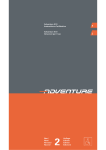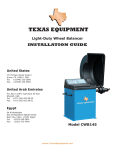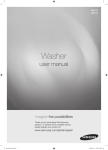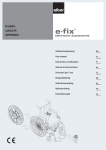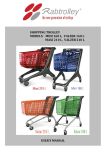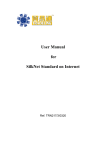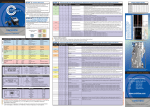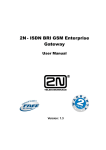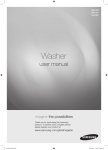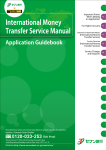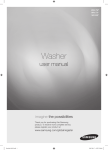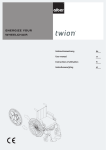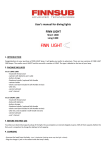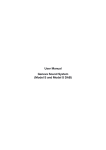Download Adventure A10 - Ulrich Alber GmbH
Transcript
Adventure A10 Gebrauchsanweisung D Adventure A10 Operating Instructions GB/US Adventure A10 Instructions d‘utilisation F Adventure A10 Istruzioni per l‘uso I Neu! New! Noveau! Nuovo! 3 Auflage Edition Edition Edizione Contents 2 Overview of the most important elements Important safety instructions - must be observed Dimensions of adventure 4 5 6 1 Standard delivery schedule 1.1 1.2 1.3 Optional parts 8 Technical data 9 General information regarding the batteries used 11 2 Individual functions on the adventure 2.1 2.2 2.3 2.4 2.5 2.6 2.7 2.8 2.9 2.10 2.11 2.12 2.13 2.14 2.15 2.16 2.17 Removing batteries Installing batteries Removing powered wheels Fitting powered wheels Removing steering wheels Fitting steering wheels Removing leg supports Fitting leg supports Folding up leg supports Connecting or disconnecting the control unit Battery charging Replacing the bulb in the front light Replacing the bulb in the indicator light Replacing the bulb in the rear light Replacing the fuse in the battery Replacing the fuse in the chassis Instructions regarding the interface on the chassis Folding the seat down or removing it completely (function and standard seats Fitting the seat unit (function and standard seats) 2.18 2.19 12 13 14 15 17 17 18 19 20 20 21 22 22 23 24 24 25 26 27 2.20 Swivelling or removing the armrest 2.20.1 - on the function seat 2.20.2 - on the standard seat 28 28 2.21 2.21.1 2.21.2 29 30 Fitting the armrest - on the function seat - on the standard seat 2.22 Removing the backrest 2.22.1 - on the function seat 2.22.2 - on the standard seat 30 31 2.23 Fitting the backrest 2.23.1 - on the function seat 2.23.2 - on the standard seat 32 32 2.24 2.25 2.26 2.27 2.28 2.29 2.30 Folding down the backrest (only for function seat) Removing the backrest cushion (only for function seat) comfort and standard cushions Fitting the backrest cushion (only for function seat) comfort and standard cushions Removing the seat cushion (only for function seat) comfort and standard cushions Fitting the seat cushion (only for function seat) comfort and standard cushions Removing the control unit Fitting the control unit 33 33 34 35 35 36 37 3 3 Driving 3.1 3.2 3.3 3.3.1 3.3.2 3.4 Electrical / manual operation Pelvic strap Getting in and out Function seat Standard seat Footrest information 4 Starting up 4.1 4.2 4.3 4.4 4.5 4.6 4.6.1 4.6.2 4.7 4.8 4.9 4.9.1 4.9.2 4.10 4.11 4.12 Individual elements of the control unit (overview) On / Off button Indicators on the display when switching on Menu setting Speed pre-selection Drive away lock Activating the drive away lock Deactivating the drive away lock Lighting Horn Modes of operation Factory settings Selection of the desired driving mode Direction indicators and hazard warning lights Fault indications on the display Joystick steering 5 Instructions for driving 5.1 5.2 5.3 5.4 5.5 5.6 5.7 5.7.1 5.7.2 5.7.3 Driver safety First driving tests Instructions for driving the adventure Dangerous ground Range Intended use Storage, transport, shipping Storage Transport Shipping 6 Care and maintenance 6.1 6.2 Cleaning Maintenance 38 39 40 40 41 41 42 42 42 43 43 44 44 44 44 44 45 45 46 47 47 56 60 60 60 62 63 64 65 65 65 65 66 66 7 Service life guarantee and liability 7.1 7.2 Service life guarantee Liability 67 67 8 Index 68 Overview of the most important components 4 Please open out the overview diagram in the appendix 1 2 3 4 5 6 7 8 9 10 11 12 13 14 15 16 17 18 19 20 21 22 23 24 25 26 27 28 29 30 31 32 33 34 35 36 37 Battery unlocking device Battery Cap Contact housing Battery holding rod Support bracket Tilt support Ejector Powered wheel Powered wheel receiver Wheel marking Wheel receiver marking Steering wheel lock Steering wheel Steering wheel holder Leg support lock Leg support Leg support holder Leg support guideway Control unit connection socket Control unit connection plug Charging socket cover Charger plug Charging socket Battery fuse Fuse compartment protective cover Interface protective cover Seat securing rod Seating unit holder Chassis holder stay Armrest lock Armrest Armrest receiver function seat Armrest star grip Armrest receiver standard seat Backrest lock Backrest stay 38 39 40 41 42 43 44 45 46 47 48 49 50 51 52 53 54 55 56 57 58 59 60 61 62 63 64 65 66 67 68 69 70 71 72 73 Backrest Backrest star grip Backrest locator Backrest rollers Guide rail Backrest guide Backrest cushion Velcro fastener Backrest cushion Backrest form Seat cushion Velcro fastener Seat cushion Seat form Control unit holder Cable clips Control unit locking device Control unit Control unit receiver Control unit studs Lever (brake activation) Control unit display On / Off button for adventure Menu control Speed pre-selection adjusting wheel Drive away lock Joystick On / Off switch for lights Horn Operating modes button Direction of movement button left Direction of movement button right State of charge display Operating mode display Magnetic key Lap belt Lap belt bracket Footrest 5 Important safety instructions must be observed! For safety reasons, the adventure may only be operated by persons who: – have been instructed in its proper handling – are physically and mentally in a state to control the adventure with complete safety under all operating conditions. The training for operating the device is included in the scope of delivery and takes place by appointment with your specialist dealer or one of the alber district managers. There is no additional charge made for this service. If you do not feel confident in handling the device, then in Germany please contact our Service Center (telephone 08009096-250) or your specialist dealer. Please also observe closely the maximum climbing performance quoted by us. Under no circumstances must this be exceeded. The driving properties of the adventure may be affected by electromagnetic fields that are produced by mobile phones and other radiation equipment. The adventure itself can also cause interference to electromagnetic fields. ! If a mobile phone or similar device is to be used, the adventure should provisionally be switched off on safe ground. Also travel close to strong electric interference fields should be avoided. Intended use The intended use of adventure is to provide indoor and outdoor mobility to persons restricted to a sitting position who are capable of operating a powered wheelchair. Disposal This device, its battery pack and accessories are long-lasting products. However, they may contain materials that prove to be hazardous for the environment if they are disposed of in places (e.g. landfills) that are not intended for this purpose according to the current applicable legislation in the respective country. The symbol of the “crossed-out refuse bin“ (in accordance with WEEE Directive 2002/96/EC) is placed on this product to remind you of your obligation to recycle. Therefore, please act in an environmentally-conscious manner and bring this product to your regional recycling centre at the end of its service life. Please familiarise yourself with the applicable legislation in your country regarding disposal, because the WEEE Directive does not apply in all European States. For example, this product does not fall under the national implementation of WEEE in the Electrical and Electronic Equipment Act as means of transport. These components are also alternatively taken back by alber or alber dealers for proper, environmentally sound disposal. Dimensions of adventure 6 Overall width, ready for driving 68 cm Overall length and height, ready for driving 1) Dependent on the leg support angle set 2) Dependent on the backrest height set 98 cm(2) 111 cm(1) Chassis dimensions (without seating unit) 1) Upper edge of seat attachment 44 cm(1) 93 cm (83,5 cm)* Packing volume: seating unit (dismantled) 36 cm 29 cm 58-60 cm * Measurements in brackets refer to adventure wheelchairs with short wheelbase. As from January 2008, these wheelchairs will be no longer available. 7 Packing volume: chassis (without wheels, with anti-tippers) 27 cm 93 cm (82,5 cm)* 62 cm (60 cm)* 45 cm * Measurements in brackets refer to Adventure wheelchairs with short wheelbase. As from January 2008, these wheelchairs will be no longer available. 1 Standard delivery schedule 8 1.1 Optional parts For details and availability of new accessories please see our adventure homepage www.adventure-news.de – – – – – – – – – – – – – – – – – – – – – – – – – – – – – – Adaptation for special backrests Attendant control Calf support Crutch holder Foam ball for joystick Footbelt Handrest extension Headrest Kerb climber Lap belt Lateral support Light and indicators Luggage bag Luggage rack Mechanical seat tilt Middle control Mudguards for the wheels Off-board charger Pelvic support Protection bumper for control unit Push handles Rear-view mirror Remote charger plug Remote on/off switch Seat height enhancement Snow chains Swivel arm for control unit T-handle for joystick Tie-down system for public transport Tray table As from January 2008, the following optional features of the adventure wheelchairs will be no longer available: - short wheelbase - standard seat - function seat with standard cushions. Details and Information on these features contained in this User Manual refer exclusively to older versions of adventure wheelchairs that have already been in use. 9 1.2 Technical data Version 6 km/h Steering wheel size 75 / 70 – 6 (diameter 26 cm, width 7.5 cm) Powered wheel size 90 / 70 – 10 (diameter 37 cm, width 10 cm) Maximum speed 6 km/h Braking system Eddy current brake with energy recovery, electromagnetic elasticity brake (locking brake) Ground clearance Turning circle 10 km/h** 10 km/h 12 km/h Remarks Max. pressure: 3,5 BAR (50 PSI), recommended pressure 2,5 BAR (36 PSI) 12 km/h 17 cm 88 cm (64 cm without footrests) Climbing performance with 140 kg load long wheelbase 18 % 18 % 18 % short wheelbase 10 % 10 % 10 % Motor design Brushless direct current motors, integrated into the wheel hub Drive design 2-step planetary transmission, maintenance free Wheel torque 50 Nm 40 Nm 40 Nm Motor nominal output 110 Watt 183 Watt 220 Watt Motor peak output 475 Watt 620 Watt 750 Watt Operating voltage Max. wheel torque 24 Volt Battery packs Lead-gel, maintenance free, leak-proof, 24 Volt Automatic battery charger 6 amps charging current, with automatic switch-off and charge conservation Range (22 Ah) with one battery pack Approx. 20 km Operation not possible Operation not possible Range (44 Ah) with two battery packs Approx. 45 km* Approx. 45 km* Approx. 45 km* Max. additional load Authorized for transportation by air freight by DOT and IATA 140 kg Total weight (empty with standard seat) long wheelbase 96,7 kg short wheelbase 96,4 kg Max. obstacle height long wheelbase Without kerb climber maximum of 8 cm, with kerb climber 12 cm The kerb climber can be ordered as an accessory short wheelbase** maximum 5 cm Kerb climber cannot be fitted **as from January 2008 no longer available 10 Weight of individual components Version 6 km/h 10 km/h** Battery pack 14,6 kg Powered wheel 11,2 kg Steering wheels with fork 2,3 kg Chassis 26,2 kg Seating unit 14,3 kg Charger 1,1 kg Total permitted weight 255 kg 12 km/h Remarks Dimensions Total length ready to drive (with anti-tippers) 111 cm Total width ready to drive 68 cm Power base (without seat) long wheelbase 93 cm short wheelbase 83,5 cm Packing volume seating unit (H x W x D) 36 cm x 50 cm x 60 cm Packing volume chassis (H x W x D) Measured with tilt supports and front wheels outside Dismantled, measured with standard seat, seat width 44 cm Without front and rear wheels, with anti-tippers long wheelbase 27 cm x 62 cm x 93 cm short wheelbase 30 cm x 60 cm x 82,5 cm Operating temperature Dependent on the leg support angle set Ambient temperature range (approx. –25 °C / +50 °C) Manufacturer‘s guarantee 2 years on complete vehicle (except wearing parts), batteries 12 months * The range varies depending on the terrain being travelled on and the prevailing driving conditions. Under optimum driving conditions (even terrain, freshly charged batteries, ambient temperature of 20 °C, even driving speed, etc.) the quoted ranges can be attained. ** Not available in the USA. The adventure complies with the EU regulation for medical products 93/42/EWG, and 89/366/EWG electromagnetic compatibility. Changes in technology and design due to constant further development excepted. Battery charger For more details and technical information please refer to the instructions enclosed with the charger. 11 1.3 General information regarding the batteries used The batteries in your adventure are maintenance free and rechargeable. Their useful service life depends strongly on the charging / discharging cycles. Through careful recharging you increase the useful life of the batteries. The electronics built into the adventure constantly monitor the state of charge of the batteries and prevent complete discharging, if properly observed. – Avoid discharging the batteries completely. Recharge the batteries of your adventure after every partial discharge, i.e. after each use. – Lead batteries are subject to self-discharge. Consequently, the batteries of the adventure should, whenever possible, always be connected to the alber mains charger. Due to charging automation, which switches to charge conservation once the batteries are fully charged, it is impossible to overcharge them. – If lead batteries are stored over a longer period of time (without being recharged), then they are subject to loss of capacity. However, after several charge / discharge cycles the full capacity is restored again. – If improperly handled, batteries may lose electrolytic fluid. This can cause injury to the skin and damage to clothing. – If skin or eyes should come into contact with the electrolyte it is vital to rinse immediately with pure water and to promptly consult a doctor. – Never subject the battery to fire or try to burn it. This could cause the battery to explode. – Do not short-circuit the battery out. A short-circuit results in very large currents which could damage the battery or the adventure. At the end of its useful service life the battery may be returned to alber or an alber specialist dealer for proper disposal. The batteries in your adventure can be used and charged in any position desired. They are classified as being as safe as dry cells and are authorized for transportation by air freight by DOT and IATA. 2 Individual functions on the adventure 12 Your adventure is a compactly constructed vehicle. Individual and service functions may be carried out with a few hand movements and largely without the use of any tools. Certain of the control elements shown in the following diagrams may deviate from those of your adventure as they are provided for left-handed or right-handed persons and so some control elements are located on the opposite side. 58 2.1 Removing batteries The following instructions apply for operation with one as well as with two batteries. – Switch the adventure off by pressing the On / Off button [58] on the control unit (see chapter 4.2). – Fold the seat forward (see chapter 2.18). – Press the unlocking mechanism for the battery [1], located at the side, downwards. Õ – Remove the battery [2]. 1 Õ 2 13 2.2 Installing batteries The following instructions apply for operation with one as well as with two batteries. – Fold the seat forward (see chapter 2.18). – Fit the cap [3] to the contact housing [4]. Õ 4 – When operating with only one battery: Place the cap [3] on the right contact housing [4]. – Place the battery in the middle of the adventure 3 – When operating with two batteries: Place the cap [3] on the centre contact housing [4]. Õ 4 3 – Press the unlocking mechanism for the battery [1], located at the side, downwards. – Place one battery [2] on the left, the other battery [2] to the right of the holding rod [5]. – Alternatively (operation with only one battery): place the battery [2] in the middle of the holding rod [5]. – When properly positioned the batteries fall automatically into the contact housings. If this is not the case, then shift the batteries to the left or right on the holding rod [5]. 1 – Pull the unlocking mechanism upwards [1]. – Switch the adventure on again by pressing the On / Off button [58] on the control unit. Õ 5 2 14 ! The cap prevents moisture entering the contact housing. Never use your adventure without having placed the cap in the correct position first. 2.3 Removing powered wheels – Switch the adventure off by pressing the On / Off button [58] on the control unit. – Fold the support bracket [6] on both anti-tippers [7] downwards. – Stand with one foot placed against the support bracket [6] on the right-hand side (to prevent sliding). 7 6 – Take the wheel in both hands and pull the adventure simultaneously back and upwards. – The right-hand side of the chassis now rests on the support bracket [6], the wheel is free. – Repeat the process on the left-hand side. 15 – With one hand pull the ejector [8] back and simultaneously with the other hand lift the wheel up slightly by its rim. The powered wheels [9] can now be pressed out of their receivers [10]. – Pull the wheels [9] completely off the receivers [10] and set them aside. 8 Õ 10 Õ 9 ! Never lay the wheels down on their stub axles. When removed from the vehicle, the wheels must never be cleaned with water as moisture may get into the electronics through the axle. 2.4 Fitting powered wheels – Make sure that the brake lever is next to the chassis (see chapter 3.1), otherwise the wheels cannot be fitted. – If not already done, place the adventure up on both its support brackets [6] (see chapter 2.3). 12 11 16 – Adjust the marking on the wheel [11] to correspond to the marking on the wheel receiver [12]. – Push the wheels [9[ fully into the wheel receivers [10]. – Fold the support brackets [6] back in. – Make sure that the support brackets [6] are securely folded away. 12 11 6 6 ! If the powered wheels [9] should not be completely engaged in the wheel receivers [10], you will get an optical warning message on the display of the control unit. An audible warning signal will also be issued. ! Prior to fitting the wheels always check their stub axles and the wheel receivers on the chassis for signs of dirt. Dirty stub axles may cause jamming during the fitting process. 17 2.5 Removing steering wheels – Position the wheels in the direction of travel. – Lift the adventure up on the side where you wish to remove the wheel. 13 Õ – With the other hand press the locking device [13] located under the wheel fork. – Keeping the lock [13] pressed, pull the steering wheel [14] downwards out of its holder. – Place the steering wheel [14] aside. – Repeat the above steps on the other side. Õ 14 ! Always ensure that the wheel stub axles are not damaged during the removal process. 2.6 Fitting steering wheels 15 13 14 – Lift the adventure up on the side where you wish to fit the wheel. – Take the steering wheel [14] into the other hand, press the locking device [13] and guide the wheel shaft into the holder [15]. 18 – Make sure, by turning the steering wheel [14] a number of times, that it is securely located in the holder [15] and will not fall out by itself. – Repeat the above steps on the other side. ! Prior to fitting the wheels always check their stub axles and the wheel receivers on the chassis for signs of dirt. Dirty stub axles may cause jamming during the fitting process. 2.7 Removing leg support Õ – Press the locking device [16] upwards and simultaneously swivel the leg support [17] upwards about 90 degrees. – Pull the leg support [17] out of the holder [18]. 16 18 17 19 2.8 Fitting leg supports – Push the leg support guideway [19] into the holder [18] – Fold the leg support [17] downwards; the locking device engages automatically. Õ 19 17 18 20 2.9 Folding up footrests – The front part of the leg supports [73] can be folded up, if required, as shown in the diagram. 73 2.10 Connecting or disconnecting the control unit Depending on the adventure model, the control unit connection socket [20] is located either on the left-hand or right-hand front side underneath the seat. – Carefully insert the plug [21] from the control unit into the connection socket [20] on the adventure. – The connection to the control unit is established automatically. 20 21 21 – If you wish to disconnect the control unit from the adventure, you just need to gently pull the control unit plug [21] out of the connection socket [20]. 20 21 ! The markings on the connection socket [20] and on the plug [21] must be aligned. 2.11 Battery charging Depending on the adventure model, the charging socket is located either on the left-hand or right-hand front side underneath the seat. – Push the cover [22] over the charging socket to the side. – Insert the plug [23] of the charger gently into the charging socket [24]. – Connect the charger to a mains power supply. 22 23 ! 24 For more details and technical information please refer to the instructions enclosed with the charger. 22 2.12 Replacing the bulb in the front light – Switch off the adventure at the control unit. – Unscrew and remove the screw on the front of the housing. – Replace the defective bulb by a new one. – Screw the two parts of the housing together again. Õ ! 6 V / 24 W K16439F1 Make sure that no wires are jammed when the housing is assembled again. 2.13 Replacing the bulb in the direction indicator light – Switch off the adventure at the control unit. – Unscrew and remove the two screws on the upper and lower sides of the housing. – Replace the defective bulb by a new one. – Screw the housing back onto the holder. 23 Õ 12 V / 18 W K15608-n9J ! Make sure that no wires are jammed when the housing is assembled again. 2.14 Replacing the bulb in the rear light – Switch off the adventure at the control unit. – Pull the two halves of the housing apart. – Replace the defective bulb by a new one. – Replace the red plastic housing back on the plastic holder. 12 V / 5 W E1 2FW ! Make sure that no wires are jammed when the housing is assembled again. 24 2.15 Replacing the fuse in the battery – Push the fuse [25], which is located at the front of the battery housing, out of the housing. – Take a fuse [25] of the same type and insert it in place. 25 25 ! Never open the battery housing. Should the fuse need replacing several times at short intervals, then please contact the alber Service Center. 2.16 Replacing the fuse in the chassis – If not already done, remove both batteries from the chassis (see chapter 2.1). – Open the protective cover [26] on the back of the chassis with the aid of a screwdriver. – Remove the defective fuse. – Insert a new fuse of the same type. 26 25 – Close the protective cover [26] and tighten the screw. 20A 3A 1A 7,5A – Replace the batteries on the chassis (see the chapter „Replacing batteries“). F3 F4 F5 F6 40A F2 40A F1 ! Always remove both batteries prior to changing the fuse. Should the fuse need replacing several times at short intervals, then please contact the alber Service Center. 2.17 Instructions regarding the interface on the chassis 27 ! There is an interface located on the chassis of the adventure which can be used by your specialist dealer for medical accessories to attach various additional features, such as electrical seat adjustment, for example. The protective cap [27] on the interface must not be removed, as damage may occur to the contacts located underneath it. 26 2.18 Folding the seat down or removing it completely (function and standard seats) – Press the securing rod [28] on the frame, located above the batteries, upwards. – Fold the entire seating unit forwards. – If desired, the complete seating unit may now also be removed. 28 ! If the seating unit is to be removed completely, then the control unit connection plug [21] must be disconnected first (see also chapter 2.10). 27 2.19 Fitting the seating unit (function and standard seats) – Hold the seating unit above the chassis at an angle of about 45 degrees. – Push the holder [29] on the seating unit into the chassis holder stay [30] on the chassis. – Fold the entire seating unit downwards. This will cause it to automatically engage with the chassis. 29 30 – Check that it is locked in place. It must not be possible to remove the seating unit from the chassis without it being unlocked first (see chapter 2.18). – Reconnect the control unit (see chapter 2.10). 29 30 28 2.20 Swivelling or removing the armrest 2.20.1 Function seat 32 33 – Pull on the locking device [31] at the lower end of the armrest. – Simultaneously tip the armrest [32] backwards. – The armrest can now stay (folded away) on the adventure, or it can be removed entirely. 31 ! – If the armrest is folded back into its initial position, it engages automatically in the receiver [33]. If the armrest [32] with the control unit is to be removed, then you must first disconnect the control unit connection plug [21] (see chapter 2.10). 2.20.2 Standard seat – The armrest on the standard seat cannot be swivelled but only removed. – Loosen the star grip [34] on the armrest [32]. – Pull the armrest [32] out of the receiver [35] and place it aside. 34 29 35 32 ! If the armrest [32] with the control unit is to be removed, then you must first disconnect the control unit connection plug [21] (see chapter 2.10). 2.21 Fitting the armrest 2.21.1 Function seat 32 33 – Push the armrest [32] into its receiver [33]. – Tip the inserted armrest [32] forwards until it engages in the receiver [33]. 32 – If required, reconnect the control unit (see chapter 2.10). 33 30 2.21.2 Standard seat – Push the armrest [32] into its receiver [35]. – Tighten the star grip [34] firmly. – If required, reconnect the control unit (see chapter 2.10). 35 32 34 2.22 Removing the backrest 2.22.1 Function seat – Press the backrest locking lever [36] down with the one hand. – Simultaneously with the other hand pull the entire backrest upwards by the stay [37]. 37 – Place the backrest [38] aside. 36 31 38 ! Always make sure that the guide rollers are not dirty or damaged. 2.22.2 Standard seat – Loosen and remove the four star grips [39]. – Pull the entire backrest [38] up by the stay [37]. – Place the backrest [38] aside. 40 39 39 – For safe keeping, screw the star grips [39] into the locator [40]. 37 ! In removing the backrest, observe the position of the holes into which the star grips are screwed. When the backrest is re-fitted, the star grips should be screwed into exactly the same holes as otherwise the position of the backrest will be different. 32 2.23 Fitting the backrest 2.23.1 Function seat – Push the backrest rollers [41] into the guide rails [42]. – Allow the backrest [38] to slide completely into the guide rails [42]. – The backrest [38] engages automatically when it reaches its end position. 38 41 42 2.23.2 Standard seat – Push the backrest [38] into the locator [40]. – Screw the backrest [38] to the locator [40] with the star grips [39]. 38 40 39 ! 39 Screw the backrest back into the same position (watch for the holes) in which it was prior to being removed. 33 2.24 Folding down the backrest (only for function seat) 38 – Press the backrest locking lever [36] downwards with the one hand. 37 – Simultaneously with the other hand pull the entire backrest upwards by the stay [37] until the guide [43] extends beyond the guide rail [42]. – Fold the backrest [38] over. 43 42 36 – In order to return the backrest [38] to its initial position push it back into the guide rail [42]. It will engage automatically. 2.25 Removing the backrest cushion (only for function seat) 45 34 – Undo the Velcro fastener [44] situated at the top edge of the backrest cushion. – Pull the backrest cushion [45] off. 44 45 2.26 Fitting the backrest cushion (only for function seat) 45 46 – Place the backrest cushion [45] properly oriented onto the backrest form [46]. – Press the backrest cushion [45] against the backrest form [46], where it will be held by the Velcro fasteners. – Pull the Velcro fastener [44] situated at the top edge of the backrest cushion over the top edge of the backrest form. 44 – Press the Velcro fastener [44] against the backrest form. 35 2.27 Removing the seat cushion (only for the function seat) – Undo the Velcro fastener [47] situated at the front lower edge of the seat cushion. – Pull the seat cushion [48] off. 47 48 2.28 Fitting the seat cushion (only for the function seat) – Place the seat cushion [48] properly oriented onto the seat form [49]. – Press the seat cushion [48] against the seat form [49], where it will be held by the Velcro fasteners. 48 49 – Pull the Velcro fastener [47] situated at the front edge of the seat cushion over the front edge of the seat form. – Press the Velcro fastener [47] against the lower side of the seat form. 47 36 2.29 Removing the control unit – If not already done, first pull the control unit plug out of the connection socket on the chassis (see chapter 2.10). – Undo and remove the two clips [51] situated at the sides of the holder [50]. The cable to the control unit that is inside the holder [50] is now exposed. 50 – Pull the locking device [52] underneath the control unit [53] backwards. 51 51 – Take the control unit [53] out of the receiver [54] and place it aside. 53 52 54 37 2.30 Fitting the control unit – Pull the locking device [52] backwards. – Place the studs [55] on the control unit into the receiver [54] on the cantilever. – Push the locking device [52] forwards. The control unit [53] should now be firmly attached to the holder [50]. 55 55 54 – Place the control unit cable into the groove underneath the holder [50]. 52 – Push the clips [51] into their locations in the holder [50]. – Connect the control unit to the chassis (see chapter 2.10). 53 52 51 50 3 Driving 38 3.1 Electrical / manual operation The lever [56] for mechanical activation / deactivation of the electromechanical brake is situated (depending on the model of adventure) on the left-hand or right-hand front side of the chassis. When the electrical drive is switched off the adventure can be switched into manual operation by deactivating the brake. Electrical operation – If the lever [56] is up next to the chassis then electrical operation is activated on the adventure. The two powered wheels can be addressed via the control unit. 56 ! During activated electrical operation the adventure may be parked on gradients (up or down) with a maximum inclination of 18 %. The powered wheels are self-locking so that it is not necessary to apply an additional brake. Manual operation – To activate manual operation switch the adventure off and push the lever [56] away from the chassis. – In this setting the brakes are deactivated to allow an escorting person to push the vehicle. 56 56 ! In manual operation the adventure may only be parked on the level as the electromechanical brake is deactivated. In an emergency, the lever [56] can be pressed forwards with light pressure so that the brake is applied and the adventure immediately comes to a standstill. ! When electrical operation is switched on and the brake is deactivated (lever [56] pulled back) a warning signal is sounded. The brake symbol also flashes on the control unit display. In this setting the adventure is braked by the electrical drive and no movement is possible. 39 3.2 Lap belt (optional extra) A lap belt [71] may be ordered from alber as an optional extra. It can be fitted subsequently to your adventure by your specialist dealer. 71 72 Function seat The lap belt bracket [72] is permanently attached to the function seat. 72 Standard seat The lap belt bracket [72] is screwed to the backrest with star grips [39]. If the backrest is removed (chapter 2.22.2) and then reattached (chapter 2.23.2), the lap belt bracket [72] must be taken off and re-attached again too. 39 72 40 3.3 Getting in and out 3.3.1 Function seat Getting into the adventure – Position the adventure as close as possible to your seat (if required, ask someone else to help you). – Make sure that the adventure is switched off. – Make sure that the adventure is in electrical operating mode (see chapter 3.1). 31 – Pull out the armrest lock [31] at the lower end of the armrest. – At the same time, fold the armrest [32] back (the armrest may be left folded back on the adventure or it may be removed entirely). – Slide onto your adventure. – Fold the armrest [32] back to its original position (it will click into position automatically). ! If the armrest [32] holding the control unit is to be removed entirely, then you must first pull out the control unit plug [21] (see chapter 2.10). If you do not possess sufficient muscular strength to get in, then you should ask an escorting person for help. If possible use a board to slide across. Getting out of the adventure – Position the adventure as close as possible to your seat. – Switch the adventure off. – Switch the adventure into electrical operating mode (see chapter 3.1). – Pull out the armrest lock [31] at the lower end of the armrest. – At the same time, fold the armrest [32] back (the armrest may be left folded back on the adventure or it may be removed entirely). 41 – Get out of the adventure. – Fold the armrest [32] back to its original position (it will click into position automatically). ! If the armrest [32] holding the control unit is to be removed entirely, then you must first pull out the control unit plug [21] (see chapter 2.10). If you do not possess sufficient muscular strength to get out, then you should ask an escorting person for help. If possible use a board to slide across. 3.3.2 Standard seat Getting in and out of your adventure is basically the same as described in chapter 3.3.1 above. On the standard seat, however, the armrest cannot be folded back, it must be removed entirely. For details please read chapters 2.20.2 and 2.21.2. 3.4 Footrest information When the adventure is pushed without occupant, the footrests must be folded up to make sure that mud guards and wheels do not scrape on them. 4 Starting up 42 4.1 Individual elements of the control unit (overview) All the functions of your adventure are executed centrally via the control unit [53], which has the following control elements: 57 – [57] Display – [58] On / Off button 63 58 – [59] Menu control 64 59 – [60] Maximum speed pre-selection adjusting wheel 65 60 61 – [61] Drive away lock – [62] Joystick 62 – [63] On / Off button for lights – [64] Horn 66 67 53 – [65] Button to activate the operating modes – [66] Button to activate direction indicator (left) – [67] Button to activate direction indicator (right) 4.2 On / Off button By pressing the On / Off button [58] you cause your adventure to become ready / not ready for operation. 4.3 Indicators on the display when switching on When the adventure is switched on the display [57] is automatically activated and, in quick succession, the following two standard displays appear: Standard display 1 Standard display 2 At the same time a system scan is carried out to check for potential errors, which if found, are indicated by visual and acoustic signals (see chapter 4.11). 43 If your adventure is ready for operation, the display switches over to operating display mode. Here the state of charge [68] of the battery and the selected operating mode (Indoor / Outdoor) [69] are always shown. The bar in the battery charge symbol [68] indicates the following states of charge: – 5 black bars: Battery capacity > 95 % – 4 black bars: Battery capacity > 80 % – 3 black bars: Battery capacity > 60 % – 2 black bars: Battery capacity > 40 % – 1 black bar: Battery capacity > 20 % (Recharging is essential immediately) – No black bar: The adventure will be switched off shortly as there is no power available any more. Error code 2 is displayed. Operating mode Indoor display 68 69 Operating mode Outdoor display 68 The background illumination on the display goes out 30 seconds after the adventure is switched on, however, the current operating status continues to be shown. 4.4 Menu setting The menu control button is used to control and activate electrical seat adjustments, which may be attached. If no electrical seat adjustment motors are attached, then the button has no function. 4.5 Speed pre-selection With the infinitely variable adjusting wheel [60] you can pre-select any desired maximum speed that your adventure should attain when the joystick is at its fullest displacement. For your first trips with the adventure we recommend that you select low maximum speed settings to enable you to learn how the system works. 44 4.6 Drive away lock The drive away lock [61] prevents the unintentional start up of the adventure and avoids it being used in an unauthorized manner; it is activated / deactivated using a magnetic key. 4.6.1 Activating the drive away lock – Switch the adventure on. – Hold the magnetic key [70] against the symbol [61] on the control unit. 70 – The drive away lock is activated, the adventure switches off automatically. – If the adventure is now switched on again the control unit is without any function, a warning indicator is shown on the display (see chapter 4.11). 61 – When drive away lock is activated only manual operation is possible. 4.6.2 Deactivating the drive away lock – Switch the adventure on. – Hold the magnetic key [70] against the symbol [61] on the control unit. 70 – The drive away lock is deactivated, the adventure can immediately be operated via the control unit. 61 4.7 Lighting The front and rear lights of your adventure are switched on and off using the button [63]. A symbol is shown on the display when the lights are on. 4.8 Horn By pressing the horn button [64] an audible signal is emitted which continues until the button is released again. 45 4.9 Operating modes 4.9.1 Factory settings Your adventure can operate in two modes - Indoor and Outdoor mode. There are different operating states behind these two modes which can be distinguished as follows: Function Indoor mode Outdoor mode Maximum speed forwards 60 % of the maximum attainable speed 100 % of the maximum attainable speed Maximum speed backwards 3,0 km/h 3,0 km/h Acceleration time Version 6 km/h Version 10 km/h* Version 12 km/h 2,3 seconds 5,7 seconds 6,3 seconds 1,8 seconds 4,6 seconds 5,1 seconds Slow down time Version 6 km/h Version 10 km/h* Version 12 km/h 2,8 seconds 6,9 seconds 7,6 seconds 2,3 seconds 5,7 seconds 6,3 seconds Turning speed Version 6 km/h Version 10 km/h* Version 12 km/h 31 % of maximum speed 20 % of maximum speed 16 % of maximum speed 28 % of maximum speed 28 % of maximum speed 15 % of maximum speed Turning acceleration / slow down Version 6 km/h 0,04 seconds Version 10 km/h* 0,03 seconds Version 12 km/h 0,03 seconds 0,08 seconds 0,08 seconds 0,06 seconds Horn Active Active Braking onset Time delayed by 30 seconds Time delayed by 30 seconds Self switch off time 1 hour 1 hour Driving signal displacement joystick 100 % 100 % Change of direction joystick No change No change * Not available in the USA. Please note the following interpretations: – Maximum speed forwards: the maximum attainable speed when the joystick is at full displacement. – Maximum speed backwards: the maximum attainable speed when the joystick is at full displacement – Acceleration time: the time taken to accelerate from standstill or from the speed being travelled at to the pre-set maximum speed. – Slow down time: the time taken for braking from the maximum speed to the desired speed or to a standstill. 46 – Turning speed: the maximum speed at which an arc of a circle or curve is travelled at. – Turning acceleration / slow down: the time taken for acceleration or slowing down while moving round a bend. – Horn: activation or deactivation of the audible signal. – Braking onset: the time between the last issuance of a driving command until the electromagnetic brakes are applied. – Self switch off time: the time during which the adventure remains ready for use before it switches itself off (to save energy). – Driving signal displacement joystick: the maximum joystick displacement required in order to give a driving command. – Change of direction joystick: changing the direction of movement stored in the joystick. ! All the above driving parameters can be adjusted to your individual requirements. Please contact your specialist dealer for this. He will be happy to advise you and to program the desired settings for you. 57 4.9.2 Selection of the desired driving mode Indoor or Outdoor mode is activated by pressing the button [65]. A visual control indicator is shown on the display [57]. 65 Display shows: Indoor mode activated („House“ visible) Outdoor mode activated („House“ not visible) 47 4.10 Direction indicators and hazard warning lights By pressing the button [66] you turn on the left direction indicator, by pressing the button [67] you turn on the one to the right. Pressing the respective button again turns the indicator off. If both buttons ([66] and [67]) are pressed simultaneously, you will turn on the hazard warning lights. To turn them off, simply press one of the two buttons [66] or [67]. Activating them results in a corresponding indication on the display. 4.11 Fault indications on the display Prior to driving your adventure you should carry out a functional check on it. Check that all components are properly tight, that the steering wheels move freely and test the brakes on level ground. The batteries should also be fully charged. Faults that may occur on your adventure are indicated on the display of the control unit. The following indications are possible: Display indication (letters flash) Control unit symbol flashes Fault description What to do Hardware fault on control unit Contact your specialist dealer or the alber Service Center EEPROM faulty or wrongly coded Contact your specialist dealer or the alber Service Center Batterie voltage range error 1. Battery defective. Check where 2 batteries are involved by inserting separately in central position. Check/replace defective fuse on battery or replace complete battery. 2. Battery fully charged. Overvoltage error when driving uphill. Remedy approx. 0,5 km uphill! 3. Battery flat! Charge storage batteries Exclamation mark lit up Code 0 Control unit symbol flashes Exclamation mark flashes Code 1 Control unit symbol flashes Exclamation mark lit up Code 2 48 Drive symbol flashes Uneven drive coding Fit power-assisted wheels with identical speed values on both sides No communication with „left“ drive Switch wheels. Contact your specialist dealer or the alber Service Center if the error code continues to be displayed No communication with „right” drive Switch wheels. Contact your specialist dealer or the alber Service Center if the error code continues to be displayed No communication with interface Contact your specialist dealer or the alber Service Center No communication with peripheral module Contact your specialist dealer or the alber Service Center Joystick fault on control unit Contact your specialist dealer or the alber Service Center Exclamation mark lit up Code 3 Drive symbol flashes Exclamation mark lit up Letter »L« flashes Code L4 Drive symbol flashes Exclamation mark lit up Letter »R« flashes Code R4 Interface symbol flashes Exclamation mark lit up Letter »S« flashes Code S4 Interface symbol flashes Exclamation mark symbol flashes Letter »P« flashes Code P4 Control unit symbol flashes Exclamation mark lit up Code 5 49 Battery symbol flashes Exclamation mark flashes Code 6 Battery configuration error and/or detection faulty (L6 = left battery pack R6 = right battery pack) Contact your specialist supplier or the alber Service Center if the error conde continues to be displayed Control unit symbol flashes No communication with special control Driving with control unit possible after reactivation on control panel! Contact your specialist dealer or the alber Service Center if the error code continues to be displayed Drive unit not compatible with control unit Fit power-assisted wheels permitted for top speed limit CPU fault on control unit Contact your specialist dealer or the alber Service Center RAM error on control unit Contact your specialist dealer or the alber Service Center ROM horizontal parity error on control unit Contact your specialist dealer or the alber Service Center Interface symbol flashes Exclamation mark lit up Code 7 Control unit symbol flashes Drive symbol flashes 1. Driving with 1 battery pack: battery not inserted in central position! 2. Driving with 2 battery packs: - one battery set defective - battery fuse (40A) defective - battery detection in interface defective Rapid error diagnosis by inserting the batteries consecutively in the middle position! Exclamation mark lit up Code 8 Control unit symbol flashes Exclamation mark symbol lit up Code 9 Control unit symbol flashes Exclamation mark symbol lit up Code 10 Control unit symbol flashes Exclamation mark symbol lit up Code 11 50 Drive symbol flashes „Left“ drive hardware/ system error Contact your specialist dealer or the alber Service Center „Right“ drive hardware/ system error Contact your specialist dealer or the alber Service Center „Left“ drive overload switch-off Brief overloading deactivates temperature! System is operationally ready again after deactivation and reactivation „Right“ drive overload switch-off Brief overloading deactivates temperature! System is operationally ready again after deactivation and reactivation „Left“ drive battery voltage range error Switch wheels. Contact your specialist dealer or the alber Service Center if the error code continues to be displayed „Right“ drive battery voltage range error Switch wheels. Contact your specialist dealer or the alber Service Center if the error code continues to be displayed Exclamation mark lit up Letter »L« flashes Code L0 Drive symbol flashes Exclamation mark lit up Letter »R« flashes Code R0 Drive symbol flashes Temperature symbol lit up Exclamation mark lit up Letter »L« flashes Code L1 Drive symbol flashes Temperature symbol lit up Exclamation mark lit up Letter »R« flashes Code R1 Drive symbol flashes Exclamation mark lit up Letter »L« flashes Code L2 Drive symbol flashes Exclamation mark lit up Letter »R« flashes Code R2 51 Drive symbol flashes „Left“ drive operating temperature switch-off Drive overheating deactivates temperature! Allow system to cool! (Cooling period depends on ambient temperature!) „Right“ drive operating temperature switch-off Drive overheating deactivates temperature! Allow system to cool! (Cooling period depends on ambient temperature!) Temperature symbol lit up Exclamation mark lit up Letter »L« flashes Code L3 Drive symbol flashes Temperature symbol lit up Exclamation mark lit up Letter »R« flashes Code R3 Temperature symbol flashes „Left“ drive operating temperature warning Exclamation mark flashes Battery capacity display lit up Drive overheating warning! Reduce load, otherwise temp. system shutdown with error L3/R3! Code L Temperature symbol flashes „Right“ drive operating temperature warning Exclamation mark flashes Battery capacity display lit up Drive overheating warning! Reduce load, otherwise temp. system shutdown with error L3/R3! Code R Drive symbol flashes Wheel code/“Left“ electronic drive error Contact your specialist dealer or the alber Service Center Wheel code/“Right“ electronic drive error Contact your specialist dealer or the alber Service Center Exclamation mark symbol lit up Letter »L« flashes Code L5 Drive symbol flashes Exclamation mark symbol lit up Letter »R« flashes Code R5 52 Interface symbol flashes Hardware fault at the interface Contact your specialist dealer or the alber Service Center CPU fault on interface Contact your specialist dealer or the alber Service Center RAM error on interface Contact your specialist dealer or the alber Service Center ROM horizontal parity error on interface Contact your specialist dealer or the alber Service Center »Left« indicator light defective Defective indicator light (change bulb) Exclamation mark lit up Letter »S« flashes Code S0 Interface symbol flashes Exclamation mark symbol lit up Letter »S« flashes Code S1 Interface symbol flashes Exclamation mark symbol lit up Letter »S« flashes Code S2 Interface symbol flashes Exclamation mark symbol lit up Letter »S« flashes Code S3 Interface symbol flashes Exclamation mark symbol flashes Contact your specialist dealer or the alber Service Center if the fault cannot be remedied in this manner Letter »S« flashes Code S5 Interface symbol flashes Exclamation mark symbol flashes Letter »S« flashes Code S6 »Right« indicator light defective Defective indicator light (change bulb) Contact your specialist dealer or the alber Service Center if the fault cannot be remedied in this manner 53 Complete seat unit* flashes Interface symbol flashes Hardware fault on peripheral module (different drive and/or relay actuation) Contact your specialist dealer or the alber Service Center CPU fault on peripheral module Contact your specialist dealer or the alber Service Center RAM error on peripheral module Contact your specialist dealer or the alber Service Center ROM horizontal parity error on peripheral module Contact your specialist dealer or the alber Service Center Exclamation mark symbol lit up Letter »P« flashes Code P0 Complete seat unit* flashes Interface symbol flashes Exclamation mark symbol illuminates Code P1 Complete seat unit* flashes Interface symbol flashes Exclamation mark symbol lit up Code P2 Complete seat unit* flashes Interface symbol flashes Exclamation mark symbol lit up Code P3 Complete seat unit* flashes Interface symbol flashes Erroneous potentiometer Contact your specialist position feedback signal dealer or the alber (only applies to drives Service Center with feedback signal) Exclamation mark symbol lit up Letter »P« flashes Code P5 Complete seat unit* flashes Interface symbol flashes Exclamation mark symbol flashes Letter »P« flashes Code P6 Multiple occupancy of »left« and/or »right« indicator key function Contact your specialist dealer or the alber Service Center 54 Complete seat unit* flashes Interface symbol flashes Multiple occupancy of »decelerate« and/or »accelerate« indicator key function Contact your specialist dealer or the alber Service Center No counter-function to »left« and/or »right« indicator key function exists Contact your specialist dealer or the alber Service Center No counter-function to »decelerate« and/or »accelerate« indicator key function exists Contact your specialist dealer or the alber Service Center Hardware fault on special control Contact your specialist dealer or the alber Service Center CPU fault on special control Contact your specialist dealer or the alber Service Center RAM error on special control Contact your specialist dealer or the alber Service Center Exclamation mark symbol flashes Letter »P« flashes Code P7 Complete seat unit* flashes Interface symbol flashes Exclamation mark symbol flashes Letter »P« flashes Code P8 Complete seat unit* flashes Interface symbol flashes Exclamation mark symbol flashes Letter »P« flashes Code P9 Control unit symbol flashes Interface symbol flashes Exclamation mark symbol lit up Letter »E« flashes Code E0 Control unit symbol flashes Interface symbol flashes Exclamation mark symbol lit up Letter »E« flashes Code E1 Control unit symbol flashes Interface symbol flashes Exclamation mark symbol lit up Letter »E« flashes Code E2 55 Control unit symbol flashes ROM horizontal parity error on special control Contact your specialist dealer or the alber Service Center Joystick fault on special control Contact your specialist dealer or the alber Service Center Internally-defined error on special control Contact your specialist dealer or the alber Service Center Internally-defined warning 1 on special control Contact your specialist dealer or the alber Service Center Internally-defined warning 2 on special control Contact your specialist dealer or the alber Service Center Special control not functioning Contact your specialist dealer or the alber Service Center Interface symbol flashes Exclamation mark symbol lit up Letter »E« flashes Code E3 Control unit symbol flashes Interface symbol flashes Exclamation mark symbol lit up Letter »E« flashes Code E4 Control unit symbol flashes Interface symbol flashes Exclamation mark symbol lit up Letter »E« flashes Code E5 Control unit symbol flashes Interface symbol flashes Exclamation mark symbol flashes Letter »E« flashes Code E6 Control unit symbol flashes Interface symbol flashes Exclamation mark symbol flashes Letter »E« flashes Code E7 Letter »E« flashes Exclamation mark symbol flashes Code E 56 Brake symbol flashes Battery capacity dislay lit up Left and right brake manually vented (L = left brake only, R = right brake only) Move braker lever to driving position! Additional L or R display indicates actuating pin jammed in wheel ejector or drive 1. Remove wheels, check actuating pin and Bowden cable in wheel ejector 2. Switch wheels from left to right (indicates which actuating pin may be jammed in drive Parking brake active Deactivate with magnetic key on control unit key symbol! Exclamation mark lit up Entire wheelchair symbol flashes Exclamation mark lit up ! The complete seat unit specified in the “Display indication“ column consists of the backrest, seat and leg support. These 3 symbols should flash together in the event of Code “P“ faults occurring. 4.12 Joystick steering The function of the joystick on your adventure may best be described as a fictitious combination of the steering wheel, gear change and accelerator of a motor car. That means that all control commands from the driver of the adventure are transmitted to the two powered wheels via the joystick. In this respect driving the adventure takes a bit of getting used to and should initially, for the first few driving hours, take place exclusively at the lowest speed and on open ground. Driving behaviour (as seen by the driver) Standstill 57 The adventure travels forwards in a straight line In travelling forwards, the adventure describes a bend to the right. The radius of the curve depends on the displacement of the joystick. The adventure turns to the right on the spot In travelling backwards, the adventure describes a bend to the left. The radius of the curve depends on the displacement of the joystick. 58 The adventure travels backwards in a straight line In travelling backwards, the adventure describes a bend to the right. The radius of the curve depends on the displacement of the joystick. The adventure turns to the left on the spot In travelling forwards, the adventure describes a bend to the left. The radius of the curve depends on the displacement of the joystick. 59 The centre position of the joystick is functionless, i.e. the wheels stand still and are simultaneously blocked by the internal brakes. Despite that the adventure should not be parked on slopes (up or down) with a gradient of more than 18 %. The joystick works just like the accelerator on a motor car. The speed may be varied at will between the joystick‘s initial position (standstill) and its full displacement (maximum speed). ! Please be sure to observe the instructions in the following chapters with regard to your first driving efforts. 5 Instructions for driving 60 5.1 Driver safety The safety and welfare of the driver are of prime importance. Consequently it is absolutely vital to learn the driving properties of the adventure. Your specialist dealer for medical equipment or the alber district manager are there to support you during the free guarantee instruction briefing. 5.2 First driving tests These should ideally take place under conditions where there is plenty of room, as the inexperienced driver seems to have a tendency to collide with furniture and other household equipment. It is therefore recommended that you practise in the open, for example in a yard, a car park or similar space. Start the adventure with its lowest speed setting (see chapter 4.5) and learn its driving characteristics under those conditions. Set yourself some simple driving tasks and carry them out rigorously in a self-developed training programme. It is impossible to force driving success, but it comes automatically after a certain amount of training. Driving training pays off in a very short time. Your steering movements with the joystick become more assured and your driving more precise. Increase the speed only very gradually. Indoors it is recommended that you maintain a low driving speed in any case. 5.3 Instructions for driving the adventure To start up never press the joystick right over to its full displacement. Particularly if the maximum speed has been pre-set, it could lead to movements of the vehicle which the driver finds uncontrollable and there is a risk of accidents. Always move the joystick gently and without jerking. Avoid jerking the joystick over to its maximum displacement, in particular in situations of potential danger that you wish to get out of the way of. As a precaution, brake the adventure until it comes to a standstill. When the joystick is released your adventure is braked. If it is necessary to brake in an emergency (immediate standstill), press the joystick briefly in the opposite direction to the one being travelled in and let it go. Never drive parallel to steep slopes or similar terrain. A possible unintentional shift in the centre of mass of the adventure could result in it tipping sideways. When driving close to steeply sloping kerbs or similar, steer a little against them. 61 Never cross minor obstructions such as kerbs by driving in parallel to them. Instead take such obstructions at right angles. This means that both wheels cross the obstruction at the same time and not one after the other. Always use a low speed, appropriate to the obstruction. Check the air pressure in the tyres at regular intervals. It influences both the driving characteristics and the range of the adventure. When crossing larger obstructions it is essential to have the support of an escorting person as there is a greater danger of tipping up. When driving on public roads the regulations of the Road Traffic Act must be observed. Your adventure is technically fitted out with the prescribed equipment. Replace tyres with worn treads or that are damaged promptly. Your specialist medical dealer or one of the alber representatives will be happy to assist you in this. The transfer to or from a wheelchair requires a lot of physical strength. If necessary, allow someone to help you do this. Prior to undertaking the transfer, switch the adventure off. That will avoid any unintentional movements through accidental contact with the control unit. You should also make sure that the parking brakes are activated (see chapter 3.1 „Switching from electrical to manual operation“), to prevent the wheelchair rolling away accidentally. When driving in confined spaces watch your lower arms. If the driveway is very narrow there is a risk of injury. Adjust your speed accordingly when going round bends. Avoid driving around sharp bends at maximum speed, particularly when the ground is also sloping. There is a risk that the adventure will topple over. Avoid driving on very smooth surfaces and roads. There is a greater risk of accidents here. To avoid crushing your limbs you must not place them within the range of movement of adjusting devices (handles, leg supports, etc.), while you are touching them. When carrying items make sure that they do not interfere with the functional areas of the adventure. Therefore do not hang bags on the sides of the adventure (they could accidentally get into the wheels), or on the joystick controller (risk of unintentional acceleration or braking). Adjust your speed to your strength. Sudden braking or fast driving around bends demand a corresponding amount of effort from the driver to hold himself / herself in place. If possible, do not drive alone or in areas where there are no other people, so that in case of a fault or a medical emergency it is always possible to get help. In manual operation mode (deactivated electromagnetic brake and vehicle switched off), with an escorting person, you do not have access to a handbrake. In this mode, therefore, the adventure must only be placed on level ground. 62 Activate electrical operation mode (fold the lever [56] towards the chassis, see chapter 3.1) without switching the adventure on. In this mode of operation an accidental rolling away is prevented by the de-energised, self-locking powered wheels. For special driving conditions such as surmounting steep gradients, obstructions or under poor road conditions call on an escorting person to help you. Under no circumstances must you overload your adventure beyond its permitted overall weight or additional weight. Particularly on sloping ground, brake your adventure gently and not jerkily. There is a greater risk of accidents here. Should you drive downhill with fully charged battery pack, for safety reasons, the control electronics of your adventure wheelchair reduce the maximum speed automatically to 2 km/h. An acoustic signal repeated 5 times plus battery symbol flashes in the control unit display provide you with information on this operating state. After negotiating the incline, the regular operating state is automatically reestablished. Immediately after charging the batteries, this operating state can also arise for a short time when driving on level ground. Avoid driving backwards on slopes. There is a risk of turning over, particularly when braking jerkily. Never cover the signal and lighting equipment with clothing, bags or similar items When an adventure is ordered its suspension is adjusted to the body weight you specify. Therefore if there is a large gain or loss in weight you should get your specialist dealer to readjust the chassis suspension. Without a readjustment, if the user gains a large amount of weight, there is a danger that the chassis may be damaged; if there is a large loss in weight the user’s personal comfort during driving is reduced. 5.4 Dangerous ground and dangerous situations Taking into account his driving skills and physical abilities, the adventure driver decides for himself which routes he will travel. Prior to setting off he must check the adventure for worn or damaged tyres, as well as the state of charge of the batteries and the proper functioning of the direction indicators. These safety checks, as well as the requisite personal driving skills, are particularly important near the following dangerous ground, which should only be tackled at the discretion of the adventure driver: – Quay walls, landing and berthing points, paths and places close to water, unsecured bridges and dikes – Narrow paths, sloping ground (e.g. ramps and driveways), narrow paths beside inclines, mountain routes – Narrow and / or sloping paths close to main arterial roads or close to chasms 63 – Leaf- and snow-covered or icy driving routes – Ramps and lifting equipment on vehicles. ! Slopes with a maximum gradient of 18 % can be driven on with the adventure without the assistance of an escorting person. However, important prerequisites are faultless tyre treads, correct tyre air pressure, a completely safe terrain and a maximum load of 140 kg. Slopes with a maximum gradient in excess of 18 % must only be driven on with the adventure with the assistance of an escorting person. Here too essential prerequisites are faultless tyre treads, correct air pressure in all tyres, a completely safe terrain and a maximum load of 140 kg. An escorting person is also necessary for crossing – Kerbs with a gradient in excess of 15 % – Obstructions of all kinds on sloping ground as there is a greater risk of tipping over in these cases. Particular care should always be taken when crossing main arterial roads, cross roads and level crossings. Never cross rail tracks in the road or at level crossings by driving in parallel to them as the wheels could get wedged in. If possible always ask some person to escort you who can push you over the road or level crossing in the event that you get stuck (e.g. due to the batteries being empty). Great care should be taken in driving on ramps attached to vehicles. During the lifting or lowering procedure the adventure must be switched off and the freewheel operation deactivated. This prevents the adventure rolling away, e.g. through unintentionally issued driving commands; and if required, an escorting person should be asked to stand by. When it is wet the tyres have less grip on the road surface; there is a greater risk of slipping. Please adjust your driving style accordingly. 5.5 Range One of the most pressing questions asked by every user of the adventure is what the range of the system is. In general, it can be stated that it will be up to 45 km when both battery-packs are in operation and up to 20 km when only one is in use. These are ideal figures and relate to travel on level, madeup ground. Deviations from these figures result from topographical conditions, the ambient temperature, the surface being driven on, tyre pressure and weight of the driver. 64 5.6 Intended use The adventure wheelchair is exclusively intended for transporting disabled persons. Do not attach components other than those authorized by Alber to the wheelchair. Before putting the adventure wheelchair into operation: – Observe the information, instructions and recommendations contained in this manual. – Do not use the wheelchair prior to receiving instructions from a person familiar with its use. – Ensure that neither the user nor third party have made technical modifications. A person familiar with its use is regarded as a person who has been instructed in the techniques of the adventure and is aware of the tasks involved and possible risks that may occur due to incorrect handling. In most cases, this is the actual driver of the adventure. Your authorized dealer or alber personnel will instruct you accordingly. Do not use the W wheelchair without receiving the necessary instructions from professional, qualified persons. Do not use the adventure wheelchair for purposes other than those intended. This applies in particular to the transportation of all types of large objects or additional persons. Do not attempt to drive onto escalators and travelators with the adventure. Do not equip the adventure with accessories other than those authorized by alber. Should this wheelchair be used contrary to the instructions and recommendations contained in this manual or exceed the technical limits defined in same, alber shall regard this as misuse of the wheelchair. alber declines all responsibility for damage resulting from misuse. 65 5.7 Storage, transport, shipping 5.7.1 Storage If your adventure is not going to be used for a longer period of time, then the vehicle and especially the batteries, must be stored in a dry place, ideally at a room temperature of +15 °C to 25 °C. In a case where the vehicle is just being stored and not used at all, the batteries should be connected to the automatic mains charger supplied by alber every two months and fully charged. This ensures that the adventure will be completely functional even after a longer period of storage. The batteries are dry cells that will not leak if handled correctly. They are maintenance free, apart from the above need to charge them. The batteries should preferably be stored standing upright (as when they are installed in the adventure). For further details about batteries please see chapter 1.3. 5.7.2 Transport As already mentioned in previous chapters, your adventure may be dismantled into several components. No special tools are required for this. In order to transport the chassis it can be lifted by the holder stay [30] and may then be pulled or pushed along on the antitipper [7] wheels. 30 7 6 Care and maintenance 66 6.1 Cleaning - All upholstery on the adventure can be cleaned with water. - Plastic parts can be cleaned with commercially available, non-aggressive detergents. - In its assembled sate, the chassis and wheels can be cleaned using a garden hose. - Removed wheels must only be cleaned with a damp (not wet) cloth. - The holders for the powered and steering wheels must always be free of dirt. Cleaning must be carried out exclusively with a dry cloth. - Steam or high-pressure cleaning devices must not be used. - Use only household cleaning agents diluted in water under no circumstances must benzene or similar solvents be used. 6.2 Maintenance Your adventure wheelchair requires a minimum of maintenance. Nevertheless, we recommend checking regularly that all parts and accessories are securely fixed. In order to ensure that your adventure wheelchair is safe to drive and functioning correctly, it should undergo a technical inspection every 2 years at the latest. In particular, damage that has occurred during use that is not visible to the naked eye as well as wear and fatigue can thus be detected. For this purpose, contact directly your authorized alber dealer. 7 Service life guarantee and liability 67 7.1 Service life guarantee The service life guarantee period for the adventure is 24 months (for batteries 12 months) and begins the day that the vehicle is handed over to the purchaser. Excluded from the service life guarantee are: - Parts subject to wear. - Maintenance work arising from daily use. - Faults resulting from natural wear and incorrect usage, in particular not observing the operating instructions. - Accidents, negligent damage, fire, water damage, acts of god and other causes beyond the control of alber. - Checking the device and finding no defects. - Devices whose serial number has been changed, disfigured or removed. The operating noise of the drive motors may increase slightly on completion of the running-in period. This is not the result of wear on mechanical components and therefore, is not included in the durability guarantee. In particular the General Standard Terms and Conditions of Ulrich Alber GmbH apply. 7.2 Liability Ulrich Alber GmbH cannot guarantee the safety and full operability of the adventure wheelchair, if - the adventure has been handled improperly - the adventure is not maintained every two years by an authorised specialist dealer or Ulrich Alber GmbH - the adventure is used in contravention of the instructions contained in this operating manual - repairs or other tasks are carried out by anyone other than authorised persons - foreign parts are attached to or combined with the adventure - parts of the adventure are dismantled or converted and therefore, is not responsible for damage that may occur. 8 Index 68 A Armrest, fitting Armrest, swivelling or removing 29 28 Backrest cushion, fitting Backrest cushion, removing Backrest, fitting Backrest, folding down Backrest, removing Batteries, general information Batteries, installing Batteries, removing Battery charger Battery charging 34 33 32 33 30 11 13 12 10 21 Cleaning Control unit, connecting or disconnecting Control unit, fitting Control unit, individual elements Control unit, removing 66 20 37 42 36 B C D Dangerous ground Dimensions of adventure Direction indicator light bulb, replacing Direction indicators Display indicators when switching on Display, fault indications Drive away lock Driver safety Driving Driving instructions Driving mode selection 62 6, 10 22 47 42 47 44 60 38 60 46 E Electrical operation 38 Factory settings Fault indications on the display First driving tests Footrests, folding up Front light bulb, replacing Fuse in the battery, replacing Fuse in the chassis, replacing 45 47 60 20 22 24 24 Getting in and out 40 Horn 44 Individual functions Indoor mode Interface 12 46 25 Joystick steering 56 F G H I J 69 L Lap belt Leg support, fitting Leg support, removing Liability Lighting 39 19 18 67 44 Maintenance Manual operation Menu setting 66 38 43 On / Off button Operating modes Optional parts Outdoor mode 42 45 8 46 M O P Packing volume Powered wheels, fitting Powered wheels, removing 6, 7 15 14 R Range Rear light bulb, replacing 63 23 Safety instructions Seat cushion, fitting Seat cushion, removing Seat, folding down or removing Seating unit, fitting Service life guarantee Shipping Speed pre-selection Standard delivery schedule Starting up Steering wheels, fitting Steering wheels, removing Storage 5 35 35 26 27 67 66 43 8 42 17 17 65 Technical data Transport 9 65 Warning lights Weight of individual components 47 9 S T W adventure A10 application class: B 57 62 53 50 38 48 37 36 9 14 1 76 2 45 44 32 43 42 29 33 30 Telefon +49 7432 2006-0 Telefax +49 7432 2006-299 www.alber.de 50.0003.4.99.04 © Ulrich Alber GmbH, Albstadt Stand: 28.10.2008 Ulrich Alber GmbH Vor dem Weißen Stein 21 72461 Albstadt Germany








































































